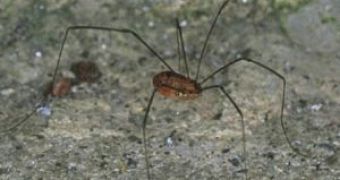Recently Matt Bowser, 26, a University of Alaska Fairbanks graduate student, has identified a new species of spider, a thumbtack-sized daddy longlegs, or harvestman on alpine rock crevices.
The spider was found north of the Sterling Highway and west of Cooper Landing, in Kenai Peninsula's Mystery Hills. Bowser couldn't find a spider to match his specimen from samples at his lab at the Kenai National Wildlife Refuge, where he is helping federal managers conduct a comprehensive study of refuge creatures.
He sent a sample to a harvestman expert, James Cokendolpher, an associate at the Natural Science Research Laboratory at Texas Tech University. Cockendolpher classified the spider as a new species and is collaborating with Bowser. Species differences in the arthropods can be very subtle. The easiest key to identify arachnids is by the genitals.
Bowser noticed hairs growing in a direction he had not seen before on the genital area. The spider is shades of brown, with beige spots. It is about 5 mm across when stretched out, compared to the 9 mm of the common, gray-brown household daddy longlegs.
Refuge manager Robin West said "You might find something new to Alaska or a range, but new to science is something else.''
Alaska's vast terrain is very little studied. Agricultural interests pay for most insect studies in the Lower 48 and in Alaska there's little farming. "It's such a frontier here,'' Bowser said. "It's pretty easy to make a contribution. In the Lower 48 you have to look harder to find something new.''
Derek Sikes, entomology curator at the University of Alaska Museum of the North in Fairbanks, said that what is most exciting about Bowser's discovery is that it means curious people are poking around Alaska. "We've yet to reach a point where we can say we know all the species-or even most of the species-in Alaska,'' he said.
"It's nice to know that there are people in Alaska now, like Matt, who are interested enough and competent enough to recognize a new species.''
The spider must undergo peer review and publication in a journal, such as the Journal of Arachnology. Sikes said experts are already aware of the find and species approval is likely.
Bowser has been trying to study spider's behavior, by observations in a terrarium or in the mountains during overnight, using an unobtrusive red light to watch them during their active periods. "They mostly sit there. They may be sitting and waiting for something (tasty) to come by,'' he said.
In terrarium the spider prefer dead flies. "Generally, harvestmen are opportunists that will kill many insects but are just as content scavenging on dead bugs," he said.

 14 DAY TRIAL //
14 DAY TRIAL //